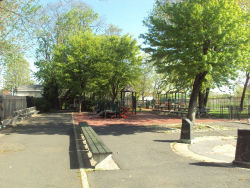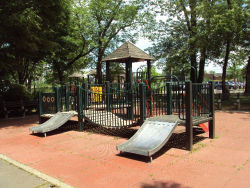Harding Park
Harding Park
In 1982 the Harding Park residents in the southeast Bronx became members of the Harding Park Homeowners Association, the first cooperatively owned low and moderate-income community in the city. The successful attempt to establish the coop was the result of a decades-long struggle for ownership in an area that originated over 300 years before in a conflict over land.
The first inhabitants of the area were the Siwanoy, Native Americans, who belonged to the Wappinger Federation. The Algonquin-speaking Siwanoy had several villages along the Bronx River, including a relatively large settlement called Snakipins (“ground nuts” in the Siwanoy language), situated near the modern intersection of Leland Avenue and Soundview Avenue. Archeologists believe the settlement had about 70 lodge sites.
The Dutch began acquiring large tracts of land from the Native Americans in 1639, including the area that was to become the Bronx. Clashes between the Europeans and various tribes marked the next few decades. As part of a three-year series of reciprocal raids known as the “Pig Wars”, Wampage, a Siwanoy leader led an attack on Bronx families including the Cornell family who had built the first farmhouse in what would become the Harding Park neighborhood. Family members who managed to escape did so only because an English ship was fortuitously passing by. A year later Thomas Cornell and his remaining family returned, and the area came to be known as Cornell’s Neck. Nearby Cornell Avenue also bears his name.
Within 50 years, wealthy New Yorkers were buying up land in the countryside for summer residences and estates. In 1720 Isaac Clason, a successful Scottish merchant and ship owner, bought 1,000 acres in the eastern half of Cornell’s Neck. The land was further subdivided in the following years and families such as the Lynches, Ludlows, Schieffelins, and Lelands all built farmhouses in the area renamed Clason Point.
By the early 20th century Clason Point was a mix of estates, farmland, and plenty of undeveloped swampland. Several landowners commercially developed their properties as picnic areas, beaches, dance halls, and amusement parks. Ferries between Clason Point and College Point in Queens ensured a steady stream of visitors, and the destination point for daylong excursions soon grew into a seasonal resort.
In the 1920s Thomas Higgs, who owned of about 100 acres of beachfront property, began leasing tents to visitors. Eventually Higgs’s Beach and the adjoining Killian’s Grove merged, incorporated, and then subdivided into small lots for a summer bungalow colony, which residents named for Warren G. Harding (1865-1923), the president at the time. After World War II a severe housing shortage inspired many Harding Park tenants to turn their bungalows into permanent homes. The community soon grew to about 250 families - mostly Irish, Scandinavian, German, and Italian - many making their living from the sea.
For the next 70 years the tenants overcame a series of threats to their homes. In 1957 they survived Robert Moses’s (1888-1981) attempt to raze what he called the “Soundview Slums.” In 1962 they countered eviction notices and rent increases and convinced the state legislature to pass a bill giving them the same rent-control protections as longtime tenants in pre-war apartment buildings. In 1979 the last private owner, Federated Homes, defaulted on outstanding tax bills and Harding Park became City property. Longtime residents and newer tenants banded together for their last challenge: convincing the City that they should own not only their homes, but also the property underneath.
In 1992, the homeowners addressed the need for recreational space. Two vacant lots along Bolton Avenue seemed ideal, but they were under the jurisdiction of the Department of Real Property (DRP). Haydee Rosario of the Homeowners Association appealed to the Department of Parks to have the lots designated parkland. After intervention by Borough President Fernando Ferrer and other local officials, the lots were assigned to Parks by DRP on May 17, 1993. Today with funding from Mr. Ferrer’s office, they offer basketball courts, play equipment with safety surfacing, spray showers arranged inside a decorative compass rose, and a contemporary pergola lined with benches. Trees provide shade for additional seating areas and a flagpole with yardarm rises over the scene.
Check out your park's Vital Signs
Clean & Safe
Green & Resilient
Empowered & Engaged Users
Share your feedback or learn more about how this park is part of a
Vital Park System





